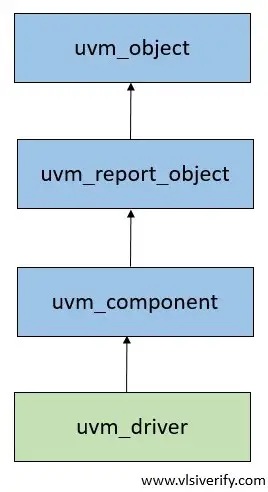UVM Driver
The driver interacts with DUT. It drives randomized transactions or sequence items to DUT as a pin-level activity using an interface. The driver has to be extended from uvm_component names as uvm_driver. The transaction or sequence items are retrieved from the sequencer and the driver drives them to the design using the interface handle. An interface handle can be retrieved from the configuration database which was already set in the top-level hierarchy.
The uvm_driver class is a parameterized class of type REQ sequence_item and RSP sequence item. RSP sequence item is optional. Usually, the REQ and RSP sequence item has the same class type. They can be different if it is declared specifically.
uvm_driver class declaration:
class uvm_driver #( type REQ = uvm_sequence_item, type RSP = REQ ) extends uvm_componentuvm_driver class hierarchy

How to write driver code?
- Create a user-defined driver class extended from uvm_driver and register it in the factory.
- Declare virtual interface handle to retrieve actual interface handle using configuration database in the build_phase.
- Write standard new() function. Since the driver is a uvm_component. The new() function has two arguments as string name and uvm_component parent.
- Implement build_phase and get interface handle from the configuration database.
- Implement run_phase to get the sequence items and drive them to the DUT using a virtual interface handle.
UVM Driver example
class driver extends uvm_driver#(seq_item);
virtual add_if vif;
`uvm_component_utils(driver)
function new(string name = "driver", uvm_component parent = null);
super.new(name, parent);
endfunction
function void build_phase(uvm_phase phase);
super.build_phase(phase);
if(!uvm_config_db#(virtual add_if) :: get(this, "", "vif", vif))
`uvm_fatal(get_type_name(), "Not set at top level");
endfunction
task run_phase (uvm_phase phase);
// Get the sequence_item and drive it to DUT
endtask
endclassHow to get sequence items from the sequencer?
TLM (Transaction Level Modelling) interface is used by the driver of type uvm_seq_item_pull_port to accept a series of REQ sequence items from the sequencer and the driver can provide optional RSP sequence items back to the sequencer if required. The details are discussed at Sequence-Driver-Sequencer communication section.
UVM driver methods
There are two ways to interact with the sequencer.
- Using get_next_item/ try_next_item and item_done methods
- Using get and put methods.
Using get_next_item/ try_next_item and item_done methods
Let’s first understand get_next_item, try_next_item and item_done methods
|
Type |
Methods |
Description |
|
task |
get_next_item (output REQ item ) |
It is a blocking method that blocks until the REQ item is available in the sequencer’s request FIFO. |
|
task |
try_next_item (output REQ item ) |
It is a non-blocking method that returns the handle of the REQ item if it is available in the sequencer’s request FIFO otherwise, it returns null. |
|
function |
item_done (RSP item = null) |
It is a non-blocking method that has to be called after get_next_item or successful try_next_item to complete the driver-sequencer handshake. It may pass the RSP sequence item as an argument to place it in the sequencer’s response FIFO. If no argument or null pointer is passed to the item_done function, it can also complete the driver-sequencer handshake. |
In this approach, get_next_item or successful try_next_item retrieves the REQ sequence item to drive it to the DUT using the virtual interface handle. The item_done method has to be called once driving logic is completed.
task run_phase (uvm_phase phase);
forever begin
seq_item_port.get_next_item(req);
// Driving logic
...
seq_item_port.item_done();
end
endtaskUsing get and put methods
|
Methods |
Description |
|
get |
It is a blocking method that blocks until a REQ item is available in the sequencer’s request FIFO. Any further calls to get() without put() call will result in a pointer for the next REQ item. |
|
peek |
It is a blocking method that blocks until a REQ item is available in the sequencer’s request FIFO. Any further calls to peek() without put() or item_done() call will result in a pointer for the same REQ item. |
|
put |
It is a non-blocking method that is used to place RSP item in the sequencer’s response FIFO. The put() is not connected to the driver-sequencer handshake mechanism. Hence, it can be called at any time. |
task run_phase (uvm_phase phase);
forever begin
seq_item_port.get(req);
// Driving logic
...
seq_item_port.put(rsp_item);
end
endtaskDifference between get_next_item/ item_done and get/ put approach?
- The item_done must be called after get_next_item() or successful try_next_item() call, then only the next sequence item can be requested. Whereas, get() call can request another request item even if the put() method is not called.
- The put() call must be called with the RSP sequence item as an argument whereas it is optional for item_done() call.
- In the case of get_next_item/ item_done approach, wait_for_item_done task (uvm_sequence_base class method) gets unblocked when item_done is called from the driver once transactions are driven to the DUT using a virtual interface. In the case of get/put approach, the wait_for_item_done gets unblocked when a put method is called from the driver where a driver has had any time to process and drive the sequence item.
- Since the sequence writer has to remember the handle of the response item, the get/put approach is more complicated to implement than the get_next_item/ item_done approach.
UVM Tutorials